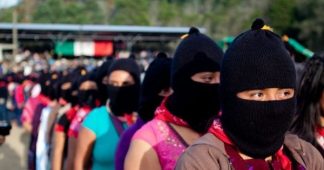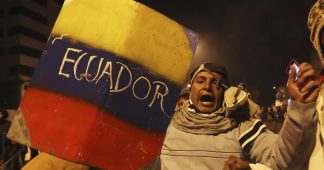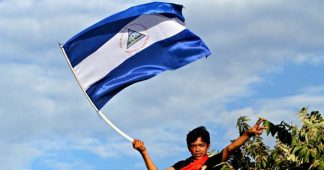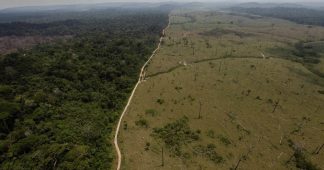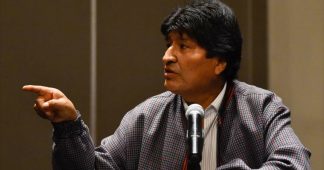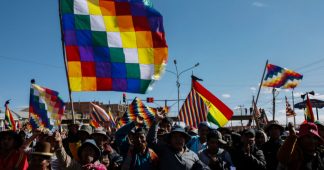Caught between organized crime, avocado cultivation, and international conservation, Indigenous towns are organizing autonomously to defend themselves
By Columba Gonzalez-Duarte and Manuel Ureste
March 24, 2021
On December 14, Doña Librada was in church when, around seven in the evening, she received an unexpected call.
“Quick,” a voice on the other end of the phone urged her, “ring the church bells.”
The 48-year-old church caretaker left her chores and pulled the ropes and rang the two bells crowning the pale blue tower that overlooks Donaciano Ojeda, a small Indigenous town located in the middle of the Monarch Butterfly Biosphere Reserve (MBBR) in eastern Michoacán, Mexico.
That night the reserve was in a state of confusion. A five-minute drive away from the church, in the neighboring town of Carpinteros, locals combed the forest in pursuit of seven armed men. The men—bearing assault rifles and ammunition-laden vests—had been sowing panic in the community for hours. They had stolen a truck from a neighbor and installed roadside checkpoints where they charged locals a fee to pass. When a family from the nearby community of Francisco Serrato refused to stop at their checkpoint, they shot at the car, killing an innocent young woman who has not been identified. They then fled.
News of the killing spread quickly. Only moments after the bells sounded, hundreds of neighbors were already gathered in the church, ready to scout the forest with machetes and shotguns. They knew that those responsible were from criminal organizations, though their specific affiliation remained a mystery. Often simply called malosos (bad guys), criminal organizations have recently deepened their foothold in the community, wreaking havoc on humans and nature alike.
That night, the malosos escaped under the cover of darkness. According to community members, a full 10 hours passed between their first call to authorities and when they eventually arrived. When the National Guard and state police reached the community, they sought to contain and disarm the local “mob.” Disillusioned with this slow and inadequate government response, members of the forest communities decided it was time for a new approach in their ongoing struggle against criminal organizations: forming their own Indigenous police and government.
Organized Crime Charges Protection Fees for Avocado Crops
“They started out very discreet; dropping some drugs here and there, and looking for accomplices, usually young men within the community to extend their network,” explains a resident who lives within the reserve and wished to remain anonymous.
In interviews, residents recall the gradual arrival of drug traffickers to their towns and forests. Before, the violence was contained to nearby cities. But over the last decade, criminal organizations have infiltrated Indigenous communities in the MBBR including Donaciano Ojeda, Carpinteros, Crescencio Morales, Francisco Serrato, and their semi-virgin Oyamel forests to which millions of monarch butterflies arrive every winter. The iconic flyers travel nearly 3,000 miles from the prairies of Canada and the East Coast of the United States to the MBBR where they overwinter from November to March.
Following the discovery of the monarch migratory phenomenon in 1976, the World Wildlife Fund for Nature (WWF) and other environmental agencies lobbied for a monarch butterfly reserve in Mexico. This came to fruition with a 1980 decree that banned all human trespassing in the “core” or central Oyamel forest. These early restrictions were met with considerable resistance from local communities whose livelihoods had long depended on communal forests.
While the reserve was meant to protect butterflies, it has ironically left the area’s other wildlife and human residents more vulnerable. Unpeopled lands like nature reserves are fertile ground for criminal activities. Conservation restrictions in the MBBR, while modified slightly in 2000, have diminished local capacity to self-govern the forest. As Hernández and Merino (2004) describe, the reserve allowed communities to “maintain land ownership devoid of the rights that define such land” (our translation). In the past, these rights kept people on the land and often supported sustainable forest management through communal institutions. Meanwhile, clientelist links between local strongmen and the state, while imperfect, provided some local security and stability.
By prohibiting human presence in the reserve’s core areas, and undermining local governance institutions, the reserve has replaced a managed forest with a sort of “frontier”: the perfect home for illicit activities. Beyond drugs, criminal organizations engage in violent enterprises such as forced disappearance, direct or indirect involvement in illegal logging, extortion, and coercion of locals for security, and avocado production.
While residents described organized crime’s earlier activities as discreet, today criminal actors increasingly openly operate with impunity. Since 2020, violence has accelerated in the eastern area of Michoacán and the neighboring Estado de México (State of Mexico) as two major cartels, La Familia and the Jalisco Nueva Generación, along with 26 other groups, compete to control the local plaza or drug distribution zone. MBBR communities are caught in the crosshairs.
While some criminal organizations are involved in illegal logging, others infiltrate communities such as Donaciano offering “help” or protection from other groups operating in their ancestral territory.
Martín, one of the many peasants who have been victims of this extortion, says, “They told us that they do not charge fees and that they do not finance loggers who destroy our forests and the monarch, as other criminal groups do. They called us and made us go down to Zitácuaro to pay a fee of 12,000 pesos [$600] per hectare of avocado. But, of course, these groups are not an NGO: in exchange for their ‘protection’ they wanted to sell crystal [methamphetamine] in the communities, or they want to initiate avocado plantations in the upper hills where monarchs and many other species live.”
To residents receiving such offers, which often come at the barrel of a gun, the promises sound empty. In this case, the Indigenous authorities rejected the proposal and demanded the organization’s immediate departure and an end to the harassment. The confrontation only increased. The result? Eleven people dead according to the community members of Cresencio Morales and Donaciano Ojeda and a firm decision: the communities would organize their own Indigenous police to regain peace in the monarch reserve.
“Either We Organize, or We Die”
Luis, a local peasant whose identity is also protected, explains that government decrees have not stopped criminal organizations like La Familia from harming people and monarchs.
“The narcos sponsor the loggers,” he says. “They give them protection to sell the wood on the black market by demanding a quota in return.”
This illegal logging has many other consequences. “Voracious logging,” explains Luis, causes rivers to change their flow and the lack of water devastates many plant species, such as pine and fir trees. This, in turn, directly impacts the monarch butterfly, which loses its food, water, and habitat. Indeed, despite current federal and international conservation programs, the downward trend in hibernating monarchs has continued.
According to the most recent data by the WWF released in February 2021, the number of butterflies decreased 26 percent compared to the previous year. The community members say they are not surprised by the discouragingly low numbers given the ineffectiveness of a conservation model that diminishes the local capacity to protect the forest. WWF did not respond to a request for comment for this story.
And it is not just logging. The forest is also an ideal place to install drug laboratories, where criminal organizations make unlimited use of the water and natural resources available to them, and ironically sell water back to communities who lack access. They are also involved in the ostensibly legal avocado industry by clearing land for avocado growers and claiming land rights payments from them.
Avocadoes, like the monarchs themselves, illustrate how a wider network of North American actors is implicated in this violence. NAFTA accelerated avocado production and its associated criminal elements, enabling urban elite consumers in the United States and Canada to enjoy avocado toast and other delicacies. As coauthor González-Duarte argues elsewhere, monarchs have similarly become a product for elite North American consumption. Northern consumers frequently demand protected landscapes in the South without acknowledging how their economic behavior and government policies shape the destruction of nature.
Foreign tourism to the reserve—which has provided communities with some income to offset their lost forest rights—is another casualty of organized crime’s presence. With increased violence, fewer local and foreign tourists are visiting monarch sanctuaries such as El Rosario, some 25 miles from Donaciano. Lost tourism income forces people to either migrate or take part in the illicit economy. Meanwhile, the decrease in international visitors—further compounded by Covid-19—has emboldened criminal groups and enabled the communities to self-organize without scrutiny.
“The drug traffickers are expanding their businesses by appropriating the forest,” sums up Luis, who also blames some community members for the uncontrolled avocado expansion.
“The community members do not cut down the forest. Traditionally it has been protected by them and their ‘grandparents’ of Mazahua or Jñato origin, as they call themselves. But there is also a lot of ambition on the part of some people who do very well with avocado and who intend to expand their plantations to the hills. And how can they do it if the community doesn’t allow them?” Luis asks. “Well, with the help of organized crime. They are the ones who do the dirty work of threatening the communities and those of us who defend the forest.”
This forest defense is risky. Global Witness has named Mexico one of the most dangerous countries in the world to be an environmentalist. Two of the most recent victims were central actors in the monarch butterfly story: Homero Gómez, who administered the El Rosario sanctuary, was found in a well after disappearing in January 2020. Raúl Hernández Romero, a monarch tourist guide, was killed just a few weeks later.
“If we don’t get organized against organized crime, they will kill us, or we will have to leave our lands, or we will have to work for them and lose our freedom,” Luis concludes.
“We Don’t Trust Authority; They do Nothing to Help Us”
León Pérez, an activist for Peace Advisory Services (Serapaz), affirms that state and private actors criminalize the area’s forest and community defenders. “There are cases of logging companies linked to organized crime that try to make people give up their territories through threats,” he says. “And if they do not succeed, they are accused of crimes they did not commit.”
Corrupt governments frequently support criminal organizations against local actors in these legal proceedings, furthering residents’ distrust of official institutions.
The legal system is not the only authority community members are questioning. The butterfly reserve itself has criminalized local livelihoods by instituting a neoliberal conservation model based on payments for ecosystem services (PES). PES in theory incentivizes conservation by granting cash to communities in exchange for protecting land. Gonzalez-Duarte’s research shows these incentives are precarious and indirectly encourage violence by confronting neighboring communities when logging occurs. For example, neighbors of Michoacán cutting down trees in Estado de Mexico or vice versa. Since payment is contingent on forest protection, communities have a further incentive to confront the more extensive logging carried out by criminal groups to keep the forest healthy and secure the PES payment.
Juan, another comunero, reflects on communities who have conformed to conservation rules but still have not thwarted the drug economy’s violence: “We don’t want the same thing to happen to us.”
The communities are taking matters into their own hands. Juan insists that their Indigenous movement has already begun: “Now the communities are united, and the enemy, whatever it may be, will have to think hard to come here. We are more than 20,000 people ready to defend ourselves.”
“We Don’t Want a Fight, but We Don’t Ask for Charity Either”
Alberto, an Indigenous community member from Crescencio Morales whose identity is also protected, takes a less combative tone. He emphasizes that the communities are not violent and that they are simply reacting to attacks by criminal organizations. Hence, what they seek is to maintain a dialogue with the authorities.
“We do not want to fight with any government, although we are not going to beg for charity either,” he clarifies. “We are asking for the right to protect ourselves, and to protect our forests and the monarch.”
On January 26, 2021, the Indigenous collective delivered a petition to authorities with three key demands: the recognition of their elected Indigenous authority, the direct allocation of budget and administrative power to manage it, and the non-intervention of any judicial power.
Community members often asserted their rights to protect themselves and their forest in interviews and their goal to return to a Mazahua (Jñato) ecological and social culture. We see this as a form of identity essentialization which, although common to many movements seeking self-government, must be analyzed critically.
It is too early to assess the implications of Mazahua autonomy for gender rights or for residents whose practices might be deemed deviant like youth, immigrants, and religious minorities. These are important questions about the future direction of self-government in the context of an internationally famous reserve, and about the fate of diverse humans who are co-existing with monarchs in this contested land.
Whether or not an agreement with the authorities is reached, Alberto emphasizes that the process of self-governance and the Indigenous Guard is already unstoppable. “Whatever happens, this is going to continue,” he insists. “Because if it weren’t for the organization of the communities, the forests, the monarch butterfly, and many of us would already be dead.”
Columba González-Duarte Ph.D. is an Assistant Professor in the Department of Sociology and Anthropology at Mount Saint Vincent University, in Halifax, Nova Scotia. Her research interests are related to monarch butterfly tri-national conservation dynamics exploring the connections between NAFTA’s agri-food industry, labor migration, and monarch decline. columba.gonzalez@msvu.ca.
Manuel Ureste is a journalist with an MA in International Relations from Staffordshire University. He works for Animal Político and was awarded the “Mexican National Award of Journalism” in 2017 and the “Ortega and Gasset Award” in 2018. Coauthor of the book ‘La Estafa Maestra,’ 2018. mureste@animalpolitico.com
Published at nacla.org
